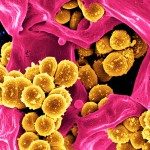Link to Pubmed [PMID] – 7532156
Int. J. Cancer 1995 Mar;60(5):597-603
We used an immunohistochemical assay with an antigen-retrieval technique to study plasminogen activator inhibitor type-1 (PAI-1) expression in paraffin-embedded breast tissue samples at different stages of malignant transformation. We detected PAI-1 in 15/20 invasive tumors. In several cases staining was localized to the stromal component. PAI-1-positive fibroblasts could be seen surrounding tumor nodules or at tumor margins. In addition, tumor-infiltrating macrophages (13 cases) and endothelial cells (5 cases) were positive. In 11 specimens PAI-1-positive cancer cells were also detected. In 2 strongly positive cases secreted PAI-1 was visible in the extracellular matrix surrounding the cells. Six of 9 samples of carcinoma in situ (DCIS) were weakly positive. No staining of endothelial cells was visible in DCIS. Only a few positive adenomatous epithelial cells could be seen in 3 of 7 papillomas. All biopsies of normal breast tissue were negative, with the exception of one sample, obtained from a patient with a previous segmental mastectomy for DCIS. PAI-1 production by invasive breast cancers could reflect a general upregulation of the plasminogen activation system in proliferating cancer cells, as suggested by the finding that normal mammary epithelium cultures expressed PAI-1 in all cases examined. In addition, production of PAI-1 by the tumor stroma could protect the tumor itself from excessive proteolysis.
